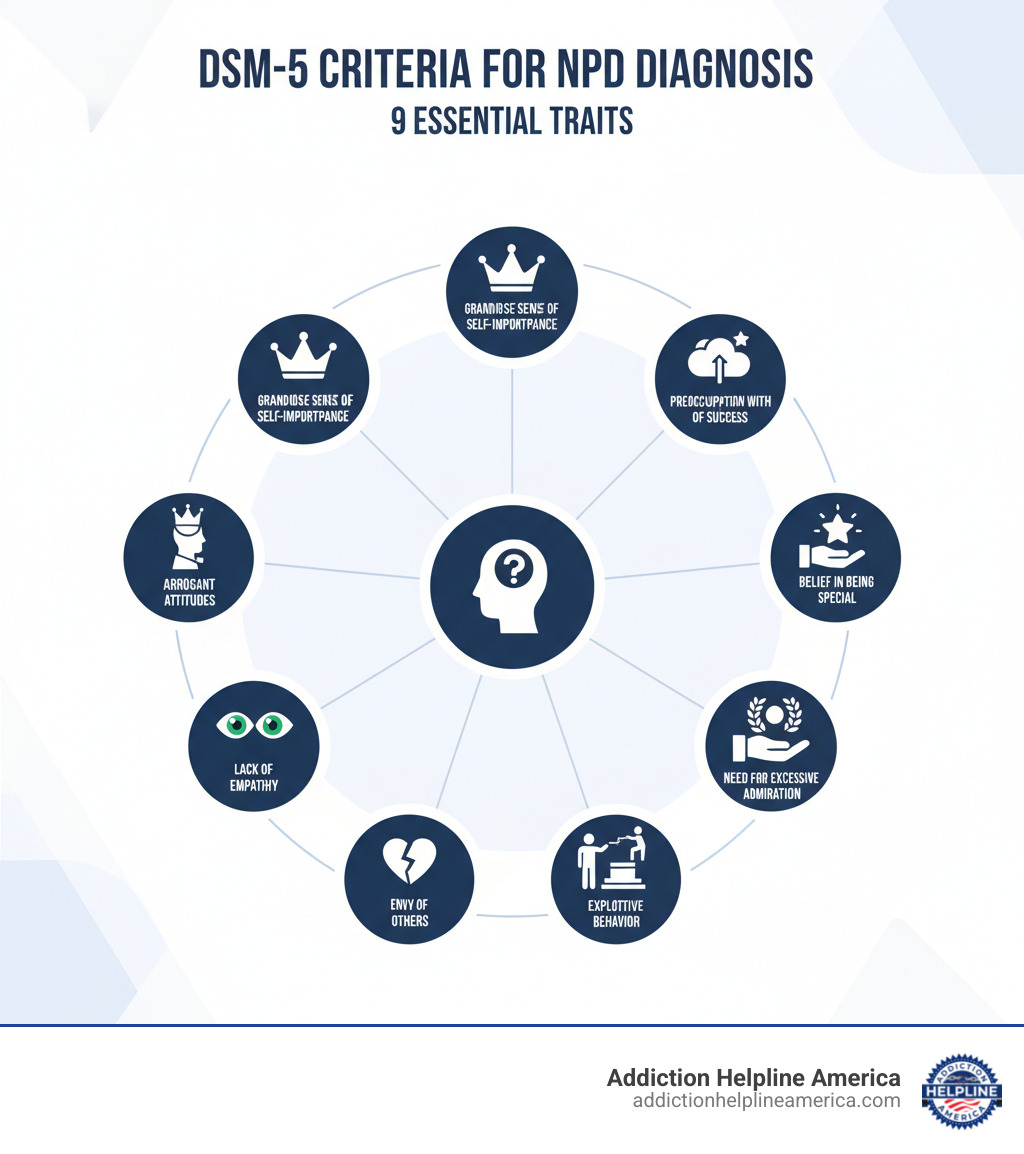
Understanding the Path to Healing from Narcissistic Personality Disorder
Narcissistic personality disorder treatment is a specialized area of mental health care focused on helping individuals manage a complex condition characterized by grandiosity, a need for admiration, and difficulty with empathy. While NPD affects between 0.5% and 5% of people in the United States, finding effective treatment can feel overwhelming—but help is available, and change is possible.
Quick Overview: What You Need to Know About NPD Treatment
- Primary Treatment: Long-term psychotherapy (talk therapy) is the main approach
- Common Therapy Types: Psychodynamic therapy, Schema therapy, Cognitive Behavioral Therapy (CBT), Dialectical Behavior Therapy (DBT)
- Medication Role: No drugs specifically treat NPD, but medications can help manage co-occurring depression, anxiety, or mood issues
- Treatment Goals: Developing self-awareness, improving relationships, managing emotions, building genuine self-esteem
- Timeline: Recovery is gradual—often taking months to years of consistent work
- Key Challenge: Many people with NPD struggle to recognize they need help or stay committed to treatment
Narcissistic personality disorder creates profound challenges in relationships, work, and personal well-being. People with NPD often experience internal struggles with self-worth that are hidden beneath a mask of confidence or superiority. The disorder is associated with higher rates of depression, anxiety, substance abuse, and even suicide risk. Yet research shows that individuals with NPD can improve over time with the right support and sustained therapeutic work.
At Addiction Helpline America, we understand how devastating mental health conditions like narcissistic personality disorder can be—not just for those diagnosed, but for their families and loved ones as well. Our team has extensive experience connecting individuals with specialized narcissistic personality disorder treatment providers who offer compassionate, evidence-based care custom to each person’s unique needs.

Narcissistic personality disorder treatment terms simplified:
- can i refuse mental health treatment
- can a teenager refuse mental health treatment
- bipolar treatment center
Understanding and Diagnosing NPD
Getting the right diagnosis is the essential first step toward effective narcissistic personality disorder treatment. But here’s the thing—understanding and diagnosing NPD isn’t as straightforward as you might think. This condition goes far deeper than simple arrogance or self-centeredness. It’s a pervasive pattern that touches every aspect of a person’s life: their sense of self, their relationships, their work, and their overall well-being.
NPD involves grandiosity (an inflated sense of self-importance), a constant need for admiration, and a significant lack of empathy for others. These patterns typically show up by early adulthood and persist across different situations. The result? Serious problems in relationships, career instability, and a reduced quality of life that often goes unrecognized by the person experiencing it.
The Challenges of Diagnosis
Even experienced mental health professionals find NPD tricky to diagnose. The biggest obstacle? Many people with NPD genuinely don’t believe they have a problem. This isn’t simple stubbornness—it’s a condition called anosognosia, which means lacking insight into one’s own mental health issues.
Imagine being told you need help for something you’re absolutely certain isn’t a problem. That’s the daily reality for many people with NPD. They might view therapy as a sign of weakness or believe that everyone else is the problem. When they do seek help, it’s usually for something else entirely—depression, anxiety, or relationship troubles—rather than the narcissistic traits themselves.
The diagnostic picture gets even murkier because NPD symptoms overlap significantly with other conditions. Borderline personality disorder, antisocial personality disorder, histrionic personality disorder, and even mood disorders like depression and anxiety can look surprisingly similar at first glance. For instance, both NPD and borderline personality disorder involve intense emotions and turbulent relationships, but the underlying causes and patterns are quite different.
Then there’s the issue of covert narcissism. Not everyone with NPD struts around demanding attention. Some people with the disorder appear shy, withdrawn, or hypersensitive to criticism. They mask deep feelings of inadequacy behind a quiet exterior, making their condition much harder to spot. This hidden form of narcissism can fool even trained clinicians.
A thorough psychological evaluation is essential. This typically includes structured interviews, psychological questionnaires, and careful application of the DSM-5-TR criteria—the gold standard for diagnosing mental health conditions. Without this comprehensive approach, NPD can easily be missed or misdiagnosed.
Grandiose vs. Vulnerable Narcissism
While the DSM-5-TR doesn’t officially recognize subtypes of NPD, researchers have identified two distinct presentations that help us understand how differently narcissism can show up: grandiose narcissism and vulnerable narcissism.
Grandiose narcissism is what most people picture when they think of a narcissist. These individuals are bold, extraverted, and overtly confident. They seek the spotlight, act entitled, and can be quite charming—at least initially. They pursue status relentlessly, lack empathy for others, and may exploit people without remorse. They seem to have high self-esteem, but scratch beneath the surface and you’ll find it’s built on shaky ground rather than genuine accomplishments or authentic connections.
Vulnerable narcissism looks completely different on the outside. These individuals appear anxious, hypersensitive, and prone to social withdrawal. They desperately need admiration just like their grandiose counterparts, but they’re extremely defensive and easily wounded. When they feel inferior or criticized, they retreat. They experience higher levels of shame, anger, and depression, often struggling in silence.
Here’s what makes this really interesting: both types can exist in the same person, especially when grandiose traits are prominent. Someone might appear supremely confident in public but privately battle intense insecurity and self-doubt. This paradox—feeling both superior to others and deeply inadequate—captures the complexity at the heart of NPD.
The Risks of Untreated NPD
When NPD goes untreated, the consequences ripple outward, affecting every area of life. The patterns of grandiosity, lack of empathy, and exploitative behavior create constant interpersonal conflict. Friendships crumble. Romantic relationships become toxic or fail completely. Despite projecting confidence, people with untreated NPD often end up profoundly isolated and lonely.
Work life suffers too. Occupational instability becomes the norm—frequent job changes, conflicts with colleagues or supervisors, and stalled career growth. The inability to accept criticism, perfectionism taken to extremes, and an overwhelming sense of entitlement create chronic workplace problems that follow them from job to job.
The mental health complications are perhaps the most concerning. Untreated NPD dramatically increases the risk of co-occurring depression and anxiety, substance abuse disorders, and even other personality disorders. People with NPD experience significant distress and have a notably lower quality of life than the general population.
Most tragically, individuals with NPD face a higher risk of suicide. These aren’t typically impulsive acts or cries for help—they’re often responses to perceived failures or narcissistic injuries that feel unbearable. The person who seemed so confident and self-assured may be privately struggling with thoughts of ending their life.
This is why narcissistic personality disorder treatment is so critical. The right therapeutic support can interrupt these destructive patterns, reduce symptoms, and help people build genuinely fulfilling lives. Change is possible—but it requires reaching out for help and committing to the often-difficult work of therapy.
Core Therapeutic Approaches for Narcissistic Personality Disorder Treatment
When it comes to narcissistic personality disorder treatment, psychotherapy—often called talk therapy—stands at the heart of the healing process. Unlike many conditions where medication plays a primary role, NPD requires a deep, sustained therapeutic relationship that addresses the complex patterns of thought, emotion, and behavior developed over a lifetime.
This isn’t a quick fix. Effective treatment for NPD typically requires a long-term commitment, sometimes spanning several years. The journey begins with something seemingly simple yet profoundly challenging: building a therapeutic alliance. For someone with NPD, trusting another person enough to be vulnerable feels like walking into a minefield. The very traits that define the disorder—the need to appear perfect, the difficulty accepting criticism, the fear of being seen as weak—can make opening up to a therapist feel impossible.
Yet this relationship becomes the foundation for everything that follows. A skilled therapist creates a safe space where an individual can gradually lower their defenses and begin addressing the core vulnerabilities beneath the grandiose exterior. It’s within this trusting partnership that real change becomes possible.
The Goals of Psychotherapy for NPD
What does successful narcissistic personality disorder treatment actually look like? It’s not about erasing someone’s personality or turning them into a different person. Rather, therapy aims to help individuals develop healthier, more authentic ways of relating to themselves and the world around them.
Developing self-awareness often comes first. Many people with NPD have spent years—sometimes decades—operating on autopilot, unaware of how their behaviors affect others or even why they act the way they do. Therapy gently illuminates these patterns, helping individuals recognize when they’re seeking validation, reacting defensively, or exploiting others. Tools like mindfulness practices and journaling can support this growing awareness between sessions.
Improving emotional regulation addresses one of the most painful aspects of NPD: the intense, overwhelming emotions that can strike without warning. Shame, rage, envy, and crushing feelings of inadequacy often lurk beneath the confident surface. Instead of lashing out, withdrawing, or doubling down on grandiosity when these feelings arise, therapy teaches healthier ways to manage emotional storms.
Building authentic self-esteem might be the most transformative goal. The inflated self-image that characterizes NPD is actually quite fragile—like a balloon that can pop with the slightest prick of criticism. Therapy works to replace this hollow inflation with something solid: genuine self-worth based on real accomplishments, internal values, and acceptance of both strengths and limitations. This shift from needing constant external validation to having an internal sense of worth changes everything.
Increasing empathy doesn’t mean forcing someone to feel something they can’t. But research shows that empathy isn’t always completely absent in NPD—it’s often blocked or underdeveloped. Through therapeutic work, many individuals find they can understand and connect with others’ feelings more deeply than they realized. This growing empathy opens doors to more meaningful relationships.
Learning to accept criticism transforms one of the most challenging aspects of NPD. When feedback feels like a life-threatening attack, people naturally become defensive or aggressive. Therapy provides a safe environment to practice hearing criticism without falling apart or striking back, gradually building tolerance for the inevitable imperfections of being human.
Fostering healthier relationships brings all these goals together. As someone becomes more self-aware, emotionally regulated, genuinely confident, empathetic, and open to feedback, their relationships naturally improve. They stop exploiting others, start considering different perspectives, and build connections based on mutual respect rather than one-sided admiration. Understanding the impact of their behavior on others becomes a natural part of how they steer the world.
Effective Psychotherapy Modalities
While no single therapy approach works for everyone with NPD, several modalities have shown real promise in clinical practice. It’s worth noting that large-scale randomized controlled trials specifically for NPD are limited—this is a challenging disorder to study—but experienced clinicians and emerging research point to several effective approaches.
Psychodynamic therapy explores the deep-rooted patterns and unconscious motivations that drive narcissistic behaviors. This approach looks at how early experiences shaped someone’s sense of self and their ways of relating to others. By bringing these hidden dynamics into awareness, individuals can begin to understand why they developed these protective patterns and gradually develop healthier alternatives. Transference-focused psychotherapy, a specific form of psychodynamic therapy, has shown particular promise for personality disorders.
Schema therapy combines elements from cognitive-behavioral, psychodynamic, and other therapeutic approaches into a comprehensive treatment. It identifies the “schemas”—deeply ingrained patterns of thinking and feeling formed in childhood—that perpetuate narcissistic behaviors. Through the therapeutic relationship and targeted interventions, individuals learn to recognize when these old patterns activate and develop healthier ways of meeting their emotional needs. Research suggests schema therapy can be particularly effective for complex personality disorders.
Cognitive Behavioral Therapy (CBT) takes a more present-focused approach, helping individuals identify and change the distorted thought patterns that maintain narcissistic behaviors. For example, someone might learn to challenge automatic thoughts like “If I’m not perfect, I’m worthless” or “Everyone should recognize my superiority.” By examining the evidence for these beliefs and developing more balanced perspectives, individuals can gradually shift their behavior patterns.
Dialectical Behavior Therapy (DBT), originally developed for borderline personality disorder, has also shown benefits for NPD, particularly when emotional dysregulation is prominent. DBT teaches concrete skills in four key areas: mindfulness, distress tolerance, emotion regulation, and interpersonal effectiveness. These practical tools can help someone with NPD manage intense emotions and steer relationships more skillfully.
Mentalization-based therapy focuses on developing the capacity to understand mental states—both one’s own and others’. For someone with NPD, learning to mentalize means becoming more aware of the thoughts and feelings driving their behavior while also better understanding what others might be experiencing. This increased psychological awareness naturally supports empathy development and healthier interactions.
The field of narcissistic personality disorder treatment continues to evolve. Researchers are exploring adaptations of these approaches and investigating which specific interventions work best for different presentations of NPD. What remains clear is that specialized, long-term psychotherapy with an experienced therapist offers the best path forward.
| Therapy Approach | Key Focus | How It Helps with NPD |
|---|---|---|
| Psychodynamic Therapy | Unconscious patterns and early experiences | Uncovers root causes of narcissistic defenses; builds insight into how past shapes present behavior |
| Schema Therapy | Deep-rooted schemas from childhood | Identifies and changes core patterns; addresses unmet emotional needs in healthier ways |
| Cognitive Behavioral Therapy (CBT) | Distorted thoughts and behaviors | Challenges grandiose or shame-based thinking; develops more balanced perspectives |
| Dialectical Behavior Therapy (DBT) | Emotional regulation and interpersonal skills | Teaches practical skills for managing intense emotions and improving relationships |
| Mentalization-Based Therapy | Understanding mental states | Increases self-awareness and empathy; improves ability to reflect on thoughts and feelings |
At Addiction Helpline America, we recognize that finding the right therapist with expertise in treating personality disorders can feel overwhelming. Our team connects individuals with experienced providers who understand the nuances of NPD and can offer the specialized, compassionate care this condition requires.
Our helpline is 100%
free & confidential
If you or someone you care about is struggling with drug or alcohol addiction, we can help you explore your recovery options. Don’t face this challenge alone—seek support from us.
Programs
Resources
Will my insurance
cover addiction
treatment?
We're ready to help
Find the best
drug or alcohol treatment
center
Are you or a loved one struggling with addiction? Call today to speak to a treatment expert.














